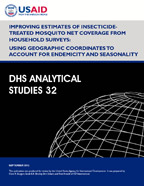- PUBLICATIONS
- JOURNAL ARTICLES
- ORDER PUBLICATIONS
Publications Summary
- Document Type
- Analytical Studies
- Publication Topic(s)
- Geographic Information, Malaria
- Country(s)
- Angola, Congo Democratic Republic, Ghana, Kenya, Liberia, Madagascar, Malawi, Mali, Namibia, Nigeria, Rwanda, Senegal, Sierra Leone, Eswatini, Tanzania, Uganda, Zambia, Zimbabwe
- Language
- English
- Recommended Citation
- Burgert, Clara R., Sarah E.K. Bradley, Erin Eckert, and Fred Arnold. 2012. Improving Estimates of Insecticide-Treated Mosquito Net Coverage from Household Surveys: Using Geographic Coordinates to Account for Endemicity and Seasonality. DHS Analytical Studies No. 32. Calverton, Maryland, USA: ICF International.
- Download Citation
- RIS format / Text format / Endnote format
- Publication Date
- September 2012
- Publication ID
- AS32
Download
 Improving Estimates of Insecticide-Treated Mosquito Net Coverage from Household Surveys: Using Geographic Coordinates to Account for Endemicity and Seasonality (PDF, 1816K)
Improving Estimates of Insecticide-Treated Mosquito Net Coverage from Household Surveys: Using Geographic Coordinates to Account for Endemicity and Seasonality (PDF, 1816K)
